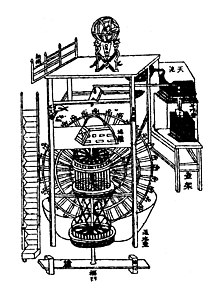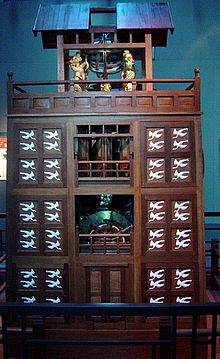Su Song
Su Song ( Chinese 蘇頌 / 苏颂 , Pinyin Su Song , Zi Zirong 子容 , Zǐróng * 1020 near Quanzhou , † 1101 ) was a Chinese polymath , in particular as inventor , engineer , cartographer , astronomer , mineralogist , zoologist , Poet , Minister and Ambassador of the Song Dynasty . His most important invention was a water-powered astronomical clock (shuiyun yixian tai), which had an escapement and a chain gear and was set up in Kaifeng . Su Song also wrote a book about this mechanism (1092), in which he described his watch in detail with 47 illustrations. It was later reproduced on a smaller scale in China (Beijing History Museum) and in London in the Science Museum.
Life
Su Song himself was a senior civil servant with a wide range of interests, including collecting art. In the examinations for the civil service career, he was placed at the top for an essay on the Chinese calendar. He was president of the Ministry of Personnel and from 1086 of the Ministry of Justice and made it to the position of Vice-President of the Secretariat of the State Chancellery. In 1063 he published an annotated edition of the Huainanzi . Politically, he stayed away from both the Conservatives and the Reformers, although many of his friends were Conservative. In 1077 he was on a diplomatic mission to the Liao dynasty of the Kitan in the north. There he also studied the Kitan calendar, which he found better than the Song Dynasty's own. There was even a diplomatic uproar because of the calendar, which was the day before the Liao and the Liao ruler's birthday fell on the winter solstice, and which the hosts believe was incorrectly dated by the embassy. The protocol officer did not receive the embassy that day. This later led to the punishment of astronomers and calendar officials. The emperor also ordered that different calendars should be tolerated and the incident was possibly a reason that the emperor asked Song Zhezong (1076–1110) to build the astronomical clock. Thanks to his good cartographic knowledge, Su Song was also able to mediate in border disputes between the Song and Liao dynasties and was commissioned in 1081 to write a history of diplomatic relations between the Song and Liao dynasties (in the end an extensive work of 200 volumes).
Astronomical clock
The complex clock was in a three-story wooden pagoda (12 m high and 7 m wide). In addition to the time of day (based on three time scales that were popular at the time) it also showed the course of the stars and planets in a bronze celestial globe on the second floor and a bronze armillary sphere for observing the sky on the top third floor. A vertical waterwheel with anchor escapement drove a vertical axis via gearwheels, which drove the eight horizontal clockwheels for the time display and the celestial globe and armillary sphere. In addition, as an alternative to the continuous vertical axis, in later improvements there was a chain gear called Himmelsleiter , which drove the armillary sphere. Over time, after Needham, the mechanism was experimented with, and adjustments and changes made. There were four types of percussion instruments (bells, drums, gong) to display the time (with four puppets performing the beats) and 158 wooden puppets that rotated on a wheel and appeared in windows to display the time. Su Song built the watch with Han Gonglian starting in 1086, the first year of the Yuanyou reign of the Northern Song Dynasty, and it took them seven years to build. It was driven by a water wheel that received water from a klepsydra (water clock). The clock was dismantled by the conquerors during the conquest of Kaifeng by the Jin Dynasty in 1127 and brought to Beijing. There they could not get it to work again, and a replica attempted in Kaifeng to replace the dismantled watch also failed. Su Song's book appeared as a block print in 1094 and ensured that the ideas embodied in the watch remained known. It was reprinted in China in the 17th and 19th centuries.
There was a long tradition of water-powered clocks in China: as early as the 2nd century BC. Zhang Heng (78 - 139 BC) built a water-powered celestial globe. In 979 Zhang Sixun built a 4 m high astronomical clock of the new type, the immediate forerunner of Su Song's instrument.
The science historian Joseph Needham published detailed studies of Su Song's clock in a book in 1960 and encouraged further study of it in England in the early 1960s. A reconstruction of the lever escapement including a demonstration on a model (1961) was made by the engineer at the General Post Office, John Combridge.
Other works
Su Song also made the oldest printed sky maps. In 1070 he and a number of scholars published a pharmacopoeia (Bencao Tujing) with a lot of information on minerals, animals and plants and on metallurgy.
literature
- Hong-Sen Yan, Tsung-Yi Lin: A study on ancient chinese time laws and the time telling system of Su Song's clock tower, Mechanism and Machine Theory, Volume 37, 2002, pp. 15–33
- Hong-Sen Yan, Tsung-Yi Lin: Comparison between the escapement regulators of Su Song's clock tower and modern mechanical clocks, in: Int. Symp. History Machines and Mechanisms - Proc. HMM 2000, Kluwer 2000, 141-148
- Joseph Needham , L. Wang, Derek de Solla Price : Heavenly Clockwork. The great astronomical clocks of medieval China, Cambridge University Press 1960
- Joseph Needham, Wang Ling: Science and Civilization in China, Volume 4, Part 2 (Mechanical Engineering), Cambridge University Press 1965, pp. 446ff
- ZC Li: History of ancient chinese astronomical clocks, China Science and Technology University Publ., Hefei 1997
- Aubrey Burstall, WE Lansdale, P. Elliott: A working model of the escapement mechanism in Su Song's astronomical clock tower, Nature, Volume 199, 1963, 1242
- JH Combridge: The chinese water balance escapement, Nature, Volume 204, 1964, p. 1175
- Xiaochun Sun: Waterpowered astronomical clock tower, in: C. Ruggles (Ed.), Handbook of Archaeoasronomy and Ethnoastronomy, Springer 2015, pp. 2133–2139
- Su Song: Xin yixiang fa yao (The Essentials of the New Instruments Method), Liaoning Yiaoyu Press, Shengyang 1997 (Su Song's manual for his watch translated into modern Chinese by Hu Weijia)
References and comments
- ↑ By Wang-Chen To in Beijing 1958. However, the model was not fully functional. Another 1: 3 scale model was shown at the 28th IAU General Assembly in Beijing in 2012, built by Sun Xiaochun and others.
- ↑ Needham, Science and Civilization in China, Volume 4, Part 2, p. 446
- ↑ Needham, Science and Civilization in China, 4.2, p. 459 and the article by Combridge in Nature 1964
| personal data | |
|---|---|
| SURNAME | Su, song |
| ALTERNATIVE NAMES | Zi, Zirong (majority name) |
| BRIEF DESCRIPTION | Chinese polymath |
| DATE OF BIRTH | 1020 |
| DATE OF DEATH | 1101 |


